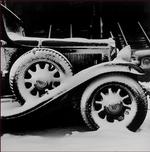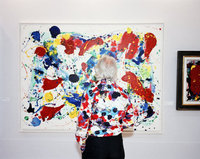It's an age old question, but perhaps you never thought it was an important link to French culture. It was one of the first lessons I learned about the cultural differences between Americans and the French.
 This happened back in 2001 when I first moved to France. After just a few months I had already done what many foreigners find challenging, I had met some Parisians. Well, I had actually met quite a few and in particular I started hanging out with six Parisian guys that I met mostly on my swim team. To strengthen my ties to this group, I decided to give a small dinner in my apartment; something I had done frequently in California and I considered myself to be an accomplished cook and host.
This happened back in 2001 when I first moved to France. After just a few months I had already done what many foreigners find challenging, I had met some Parisians. Well, I had actually met quite a few and in particular I started hanging out with six Parisian guys that I met mostly on my swim team. To strengthen my ties to this group, I decided to give a small dinner in my apartment; something I had done frequently in California and I considered myself to be an accomplished cook and host.
Not being one to leave things to chance, I planned a menu of really good food that I was very confident preparing. I started with a salade composée, a simple green salad with a slice of Herby Italian Ham and a small round of runny Rocamadour cheese. The main course was to be pan-seared Chicken Breasts with Herbes de Provence and white wine with a buttery reduction sauce and several vegetables. This is one of my secret recipes that is no-fail, and can work with a variety of meats. I bought very expensive free-range Poulet de Bresse chicken breasts. This is the most prized chicken in France and they are recognizable by their black-skinned legs and feet. Not understanding this, I had the puzzled butcher trim them into tidy breast portions. To finish, I planned a cheese course and individual molten chocolate cakes.
Well, everyone arrived late as I later learned is customary. If you are invited to someone's home in France, you are expected to arrive at least 15 minutes late. Arriving on time is bad form and you will often catch your host or hostess in a state of half-dressed panic.
Things started well with a little aperitif cocktail and then we headed to the table. First course was warmly received with people enjoying the combination of flavors. However, the chicken, which was tender, juicy and delicious, received nearly no comments. I was surprised, to say the least. After all, this was a time-tested winning recipe that was always a big hit "back home."
The cheeses and chocolate cakes were happily received. This is another signature dish, individual molten chocolate cakes served like soufflés in ramekins. They look complicated but are prepared ahead and baked off at the start of the cheese course. This dish conforms to my second rule for a great dinner party; "presentation is more important than complication."
Overall the evening was a success, but no one made any compliments about the meal or even thanked me for my efforts. Given the miniscule size of my Paris kitchen I thought it was an amazing feat that I prepared a dinner for six in a space about the size of an average telephone booth. Well, it turns out that most kitchens are this small so this was no feat to them.
I was quite puzzled by the outcome of my dinner and admittedly it was vanity that led me to investigate. After all, that was really good chicken. I spoke with my French tutor to see if she could shed any light on my experience. What I learned was the first of many unspoken cultural rules relating to food that exist in France.
She said that chicken, like pasta, was more of a family meal than something for a special dinner for new friends. When I pressed further for details she responded that there was a time, just after World War II when she was a child, when it was very hard to get chicken and therefore it was something of a delicacy. But today, that isn't the case. So I realized that serving chicken to my friends was nearly the equivalent of serving hot-dogs to adults at a dinner party. Oops...
In an effort to make up for this mistake and also see if a different menu would elicit a different response from the same group, I planned another dinner for the same six people. I had not mentioned to any of them about what I had learned about chicken. The occasion was my birthday and the main course was a classic Boeuf aux Carrottes, with cumin seeds and orange to make it a bit more interesting. They were delighted and fell all over themselves to compliment me on the dinner.
But here I learned another cultural lesson. Their compliment was, "This is excellent, you really found a good butcher," and no mention of my efforts in the kitchen. Well, apparently this is the highest praise. It's expected that anyone can cook well and the real trick is being savvy enough to find an excellent butcher when there are three or four choices in every neighborhood.
Well, at this point I took the compliment and ran with it. In the ensuing years I have had countless dinner parties in Paris and have never served chicken again.
Note: I have since learned that the only way to serve roast chicken in this setting is to buy small half "Poulet de Bresse" chickens and serve them with the legs and black skin attached (which is a sign of their quality) and serve one per person. Personally, I think it's more fun to make something more interesting.
 Tuesday, December 15, 2009 at 10:57PM
Tuesday, December 15, 2009 at 10:57PM  Museums in
Museums in  Armchair Paris,
Armchair Paris,  Photography,
Photography,  Picture of the Week
Picture of the Week 


